Think about developing a fitness app? You're not the only one. With the international fitness app market expanding to an estimated $14.64 billion in 2027, it's little surprise that increasingly people are looking to fitness technology. And why not? Busy lifestyles and a greater desire for personalization aside, fitness apps give people an instant, convenient, and efficient way of getting fit. If you want to learn more about the growing intersection of health and fitness, check out our Health and Fitness App Development: A Blessing In Healthcare Industry
But what is the key to creating a successful fitness app? Let's find out the most successful ones, jaw-dropping stats, motivational success stories, a technology must-have, and most importantly, how you can get a good return on investment (ROI).
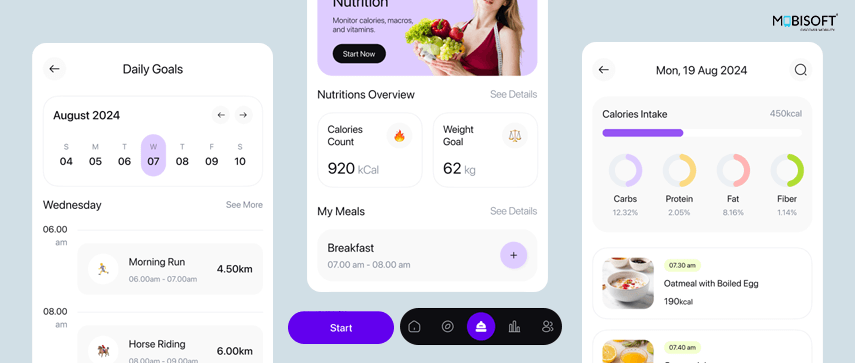
New Trends in Fitness App Development
The fitness app market continues to evolve. Among the most sought-after fitness app features are:
- AI and Machine Learning Personalization: Fitness apps are employing AI to create personalized workout routines, dietary advice, and progress reports based on user data. This is a common feature in healthcare mobile app development, enabling better patient engagement and care.
- Wearable Device Integration (IoT): Integration with devices like Fitbit and Apple Watch to provide a seamless experience with health data like heart rate, steps, and calories burned. Fitness apps that use wearable devices also share parallels with healthcare product development in terms of real-time health monitoring.
- Gamification: Using challenges, leaderboards, badges, and sharing to motivate users to keep moving.
- Virtual Workouts & Online Classes: Apps offering live and on-demand classes with top trainers.
- Mental Health Integration: Apps providing meditation, mindfulness, and sleep monitoring to foster a balanced lifestyle.
- Social & Community Building: Apps that allow users to share successes, be part of a community, and motivate one another.

AI-Driven Personalization
Employing AI to offer customized workout routines, dietary advice, and fitness monitoring. Virtual trainers leveraging machine learning for instant feedback.
Integration with Wearable Devices
Seamless synchronization with health bands, smartwatches, and health wearables. Collecting information such as sleep cycles, heart rate, calories burnt, etc., for enhanced insights.
Chatbots and Voice Assistants
Chatbots powered by artificial intelligence to dispense exercise guidelines, answer inquiries, and track progress. Hand-free workout directions through voice-enabled apps.
Community & Gamification
Adding social aspects such as leaderboards, challenges, and group activities. Reward systems in order to improve motivation and retention.
Immersive Exercises (AR/VR)
Augmented Reality (AR) and Virtual Reality (VR) interactive fitness experiences. Fun fitness games that turn exercise into a game.
Hybrid Fitness Platforms
Live streaming, on-demand lessons, and virtual coaching applications. Blending offline and online experiences for added flexibility.
Mental Well-being Integration
Mindfulness and meditation aspects to aid total well-being. Tracking mental well-being indicators such as mood, stress levels, etc.
Data-Driven Observations
Applying Big Data analytics to offer predictive recommendations and personalized advice. Visual dashboards to track progress and establish goals.
Enhanced Security & Data Privacy
To ensure GDPR, HIPAA, and other data protection laws compliance. To provide users with control over their data.
Subscription Models & In-App Purchases
Freemium offerings with premium features for monetization. Offering personalized training packages and diet plans.
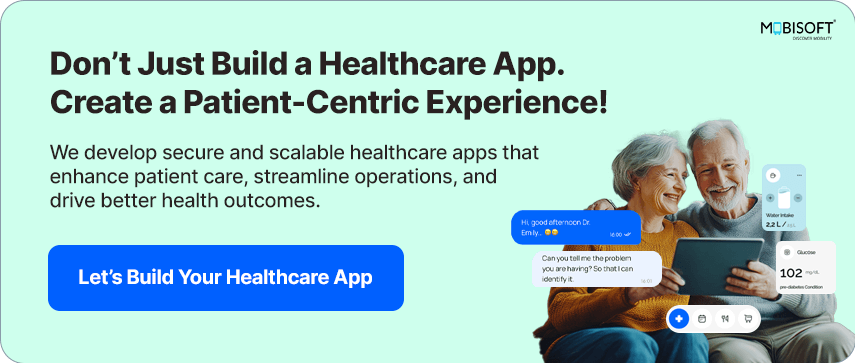
Technology & Integrations
To build a different fitness app, the right technologies are required:
- AI & Machine Learning: Intelligent algorithms not only personalize exercise routines but also improve the user experience by anticipating user actions and providing suggestions for enhancement.
- IoT (Internet of Things): Integration of wearable devices and intelligent gym equipment is revolutionary, offering real-time data and end-to-end health insights.
- Cloud Computing: Seamless operation demands effective processing, storing, and scaling of the user data.
- Blockchain: Providing yet another level of protection and transparency for health-sensitive information. Most suitable for medical wellness applications.
- Voice Recognition & NLP: Hands-free exercise programs and voice-controlled functioning are becoming steadily more convenient.
- Third-Party Integration: APIs to fitness trackers, social media, diet programs, and payment processors are necessary to enrich the experience of the user.
Eye-Opening Stats
Global Growth:
The world fitness app market is growing with tremendous speed, worth $16.1 billion in 2023 and is expected to increase at a CAGR of 17.9% during 2024-2032. The revenue will reach $45.9 billion in 2029 with a CAGR of 26.7%.
User Growth:
The market had 368 million users and more than 850 million downloads in 2023.
Revenue Sources:
- In-app purchases: $3.7 billion
- Paid apps: $0.17 billion
- Advertising: $1.09 billion
Key Market - United States:
The United States remains a key market, contributing around $1.993 billion in revenue in 2022.
Drivers for Growth:
- Growing health awareness
- Convenience in working out at home
- AI-enabled personalization
- Wearables integration
User Engagement:
- 72% of fitness app users utilize theirs once a week.
- Nearly 30% use theirs every day.
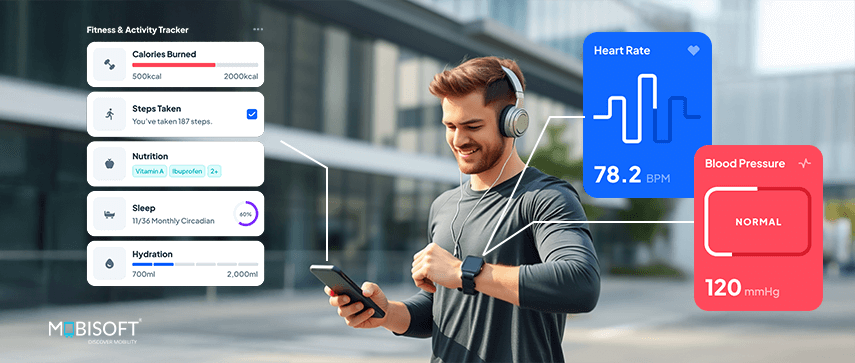
Wearable Fitness Trackers:
Wearable fitness trackers will represent 1.1 billion connected devices by 2025, once again driving demand for apps.
Most Widely Used Categories:
The most widely used categories of fitness apps are:
- Workout and exercise apps
- Diet apps
- Activity tracking apps
- Meditation apps
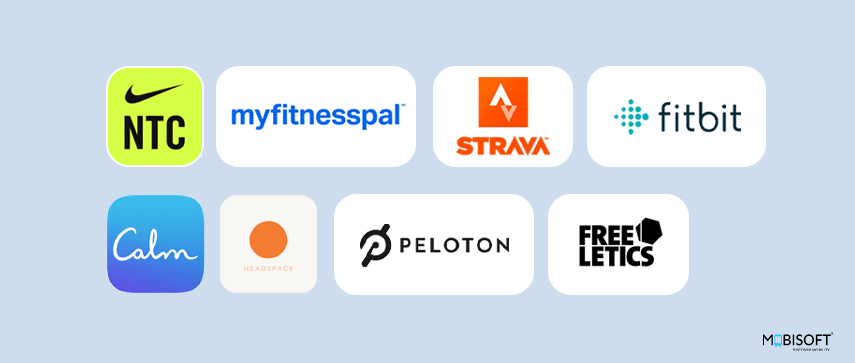
Success Stories
- Nike Training Club (NTC): Nike Training Club was phenomenally successful by providing personalized training plans, gamification, and top-quality content free of charge during the pandemic, clocking more than 50 million downloads globally.
- MyFitnessPal: MyFitnessPal, with its massive food database and AI-based meal recommendations, was a leader in nutritional monitoring, which was sold in 2020 for $345 million.
- Strava: Strava created a successful community of runners and cyclists by monitoring performance, socially connecting, and competing, with more than 100 million members in existence today around the world.
- Fitbit App: Fitbit App, combined with Fitbit devices to offer end-to-end health monitoring, leading to Google's $2.1 billion purchase in 2021.
- Peloton Digital: Peloton Digital possessed hybrid fitness platforms that intertwined software and hardware in packages, growing exponentially throughout the pandemic through on-demand lessons.
- Freeletics: Freeletics uses AI-coaching to offer personalized bodyweight training, achieving success also in nutrition coaching with over 53 million registered users worldwide.
- Future: Future offers one-to-one coaching over video calls, creating a subscription-based model that drew significant investor investment.
- Headspace and Calm: Headspace and Calm branched out from mental wellness to encompass fitness-oriented mindfulness and sleep education, accumulating millions of subscribers worldwide.
Potential Businesses & Sources of Income
Possible Businesses:
- Personalized Fitness Coaching Apps: Workout and diet plans based on AI-driven user objectives. These apps share a similar development structure to healthcare software development applications that track and monitor patient progress.
- Wearable-Integrated Apps: Apps that integrate with wearables such as smartwatches and fitness bands to monitor health in real-time.
- Mental Health Apps: Combining meditation with fitness, sleep tracking, and mental wellness improvement.
- On-Demand Fitness Platforms: Providing live and on-demand fitness classes, one-on-one training, and hybrid experiences.
- Social Fitness Networks: Apps that are focused on social fitness challenges, leaderboards, and social interactions.
- Health & Fitness Marketplaces: Websites that connect consumers with trainers, dietitians, and wellness professionals.
- Corporate Wellness Solutions: Employee wellness program and engagement apps.
Sources of Income:
- Subscription Plans: Ad-supported or paid plans providing enhanced features, customized training, or ad-free usage.
- In-App Purchases: Promotion of workout plans, diet guides, merchandise, or fitness challenges.
- Ad revenue: Sponsorship by health brands or fitness equipment manufacturers.
- Affiliate Marketing: Getting paid commissions for selling fitness equipment or products.
- Paid Apps: Offering a single paid download for advanced features.
- Data Monetization: Selling anonymized and aggregated user data to researchers and the fitness-related industries.
- Corporate Partnerships: Fitness clubs, health businesses, or clinics as partners.
ROI: Is It Worth It?
The fitness app market has strong ROI potential driven by increasing health consciousness, technology, and increasing smartphone penetration. Successful apps like MyFitnessPal, Strava, and Peloton have generated lucrative returns through subscription, in-app purchases, advertising, and partnerships.
Investing in creating fitness apps can prove to be highly profitable if approached through a well-researched methodology. Factors that contribute to ROI and make this investment profitable include the fact that they offer niche experiences, are AI-friendly, employ wearables-based data, and provide subscription-premium content. The monetization streams and global usage base justify the investment.
Cost of Development (Total Investment)
- App Designing & Development: $80,000 – $150,000
- Marketing & Promotions: $20,000 – $50,000
- Maintenance & Updates: $10,000 – $30,000 per year
- Operational Costs (Hosting, Support, etc.): $5,000 – $15,000 per year
- Total Initial Investment: $115,000 – $245,000
Revenue Generation (Yearly)
Subscription Revenue
- Monthly Subscription Fee: $10
- Average Users with Subscription: 50,000
- Annual Revenue: 50,000 x $10 x 12 = $6,000,000
In-App Purchases:
- Average Monthly Sales: $50,000
- Annual Revenue: $50,000 * 12 = $600,000
Advertising Revenue:
- Estimated Ad Revenue per User per Month: $0.50
- Total Users: 500,000
- Annual Revenue: 500,000 x $0.50 x 12 = $3,000,000
Partnerships and Affiliate Marketing:
- Estimated Annual Revenue: $200,000
Total Revenue Every Year:
$6,000,000 + $600,000 + $3,000,000 + $200,000 = $9,800,000
ROI Calculation Scenarios
Low Growth Scenario:
- Initial Investment: $245,000
- Annual Revenue: $4,000,000
- Annual Profit: $4,000,000 - $245,000 = $3,755,000
- ROI: (3,755,000 / 245,000) x 100 = 1,532%
Medium Growth Scenario:
- Initial Investment: $200,000
- Annual Revenue: $6,000,000
- Yearly Profit: $6,000,000 - $200,000 = $5,800,000
- ROI: (5,800,000 / 200,000) x 100 = 2,900%
High Growth Scenario:
- Initial Investment: $150,000
- Annual Revenue: $9,800,000
- Annual Profit: $9,800,000 - $150,000 = $9,650,000
- ROI: (9,650,000 / 150,000) x 100 = 6,433%
Tips for Success
To be successful in the fitness app industry, focus on:
- Personalization: Offer AI-based workout plans and nutrition advice tailored to users.
- Compatibility: Offer seamless integration with top wearables and support for leading platforms.
- Retention: Blend virtual and face-to-face learning experiences to appeal to various tastes.
- Data Protection: Protect user data with strong privacy controls and build trust with transparency.
- Marketing: Effective marketing with influencers, targeted ads, and engaging content will make your brand.
- Regular Updates: Continue to update the app on a regular basis with fresh content, functionality, and gamification elements like rewards and challenges to engage users.
- Monetization: Have flexible monetization strategies and allow the app infrastructure to support growth nicely.
- Partnerships: Teaming with fitness brands, gyms, and wellness professionals can assist in attaining credibility and scale.
Conclusion
The fitness app market is booming, but it's not just a great concept that's needed to arrive here. With the right alignment with the trends, learning from the success stories, leveraging the right technologies, and creating an incredible user experience, you can create a fitness app that not only changes lives but also brings an enormous return on investment (ROI). Ready to create your fitness app concept? Let's start!


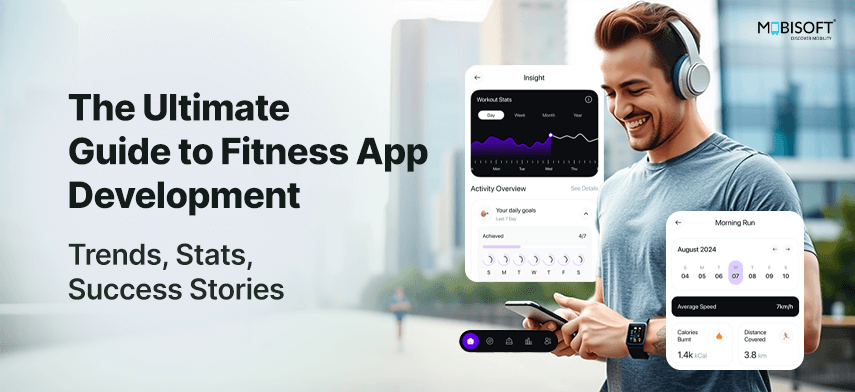


 March 26, 2025
March 26, 2025


